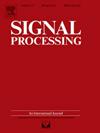精确的频率估计通过迭代抛物线插值
IF 3.4
2区 工程技术
Q2 ENGINEERING, ELECTRICAL & ELECTRONIC
引用次数: 0
摘要
从复杂信号中提取频率在许多应用中是一项常见的任务,在不同的噪声条件下存在多种精确的频率估计方法。基于离散傅立叶变换(DFT)插值的迭代算法已知具有很高的精度,而在DFT峰值周围使用辅助系数的方法在文献中反复出现。本文提出了一种基于连续抛物插值的频率估计迭代算法。与其他类似的方法不同,这些方法通常需要辅助精细估计器来减少偏置,该方法通过逐步减少每次迭代时使用的DFT系数的偏移量来改进频率估计。这种方法消除了外部校正步骤的需要,并提高了估计精度,因为插值在真实频率周围变窄。该算法在保持计算效率的同时,实现了非常接近cram本文章由计算机程序翻译,如有差异,请以英文原文为准。
Accurate frequency estimation through iterative parabolic interpolations
Extracting the frequency from a complex signal is a common task in many applications, and multiple methods exist for accurate frequency estimation under different noise conditions. Iterative algorithms based on the interpolation of the discrete Fourier transform (DFT) are known to achieve high accuracy, and methods that employ auxiliary coefficients around the peak of the DFT are recurrent in the literature. This paper presents a novel iterative algorithm for frequency estimation based on successive parabolic interpolations of three DFT coefficients. Unlike other similar methods, which typically require auxiliary fine estimators for bias reduction, the proposed method refines the frequency estimate by progressively decreasing the offset of the DFT coefficients employed at each iteration. This approach eliminates the need for external correction steps and enhances estimation accuracy as the interpolation narrows around the true frequency. The algorithm achieves performance very close to the Cramér-Rao lower bound while maintaining computational efficiency, and the fine estimation step implemented can be flexibly applied to signals with or without zero-padding, making its use suitable for a wide range of signal processing applications. Simulations confirm the high accuracy and robustness to noise of the proposed estimator, showing comparable or better performance than existing iterative techniques.
求助全文
通过发布文献求助,成功后即可免费获取论文全文。
去求助
来源期刊

Signal Processing
工程技术-工程:电子与电气
CiteScore
9.20
自引率
9.10%
发文量
309
审稿时长
41 days
期刊介绍:
Signal Processing incorporates all aspects of the theory and practice of signal processing. It features original research work, tutorial and review articles, and accounts of practical developments. It is intended for a rapid dissemination of knowledge and experience to engineers and scientists working in the research, development or practical application of signal processing.
Subject areas covered by the journal include: Signal Theory; Stochastic Processes; Detection and Estimation; Spectral Analysis; Filtering; Signal Processing Systems; Software Developments; Image Processing; Pattern Recognition; Optical Signal Processing; Digital Signal Processing; Multi-dimensional Signal Processing; Communication Signal Processing; Biomedical Signal Processing; Geophysical and Astrophysical Signal Processing; Earth Resources Signal Processing; Acoustic and Vibration Signal Processing; Data Processing; Remote Sensing; Signal Processing Technology; Radar Signal Processing; Sonar Signal Processing; Industrial Applications; New Applications.
 求助内容:
求助内容: 应助结果提醒方式:
应助结果提醒方式:


